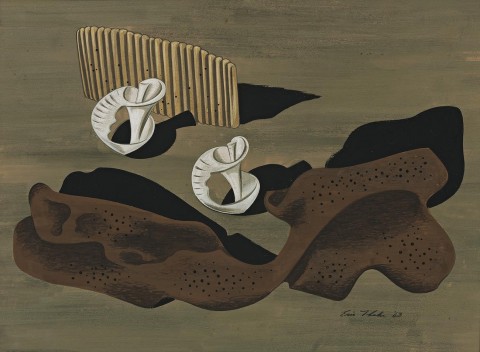BASS AND FLINDERS, 1943
ERIC THAKE
gouache on paper
25.0 x 34.0 cm
signed and dated lower right: Eric Thake ‘43
signed, dated and inscribed with title verso: BASS AND FLINDERS / Eric Thake 1943 / Painted from objects / found on Flinders Beach
Mr & Mrs John Bullock, Adelaide
Private collection, South Australia
Deutscher and Hackett, Melbourne, 29 August 2007, lot 3
Private collection, Sydney
Eric Thake: A Retrospective Exhibition, National Gallery of Victoria, Melbourne, 21 May – 4 July 1970, cat. 34
Master landscapes of the Mornington Peninsula: 1800 to the present, Mornington Peninsula Regional Gallery, Victoria, 9 December 2009 – 8 March 2010 (label attached verso)
Eric Thake: a retrospective exhibition, National Gallery of Victoria, Melbourne, 1970, cat. 34, p. 7
Thake, E., ‘On getting some Ideas for Pictures’, typewritten notes for a talk at the ‘Medial Art Society Exhibition’, Victorian Artists’ Society Gallery, 12 September 1963, Eric Thake Papers, MS 9826, State Library of Victoria, Melbourne
Thomas, D., ‘ERIC THAKE, Bathing Boxes, Flinders, 1930’, Landscapes of the Mornington Peninsula. Commissioned Essays, Mornington Peninsula Regional Gallery, Victoria, 2009, p. 13
Eric Thake is one of the most original artists Melbourne has produced. A master of the unexpected, witty, whimsical and perceptive with a penetrating eye matched by technical mastery, his work has long been admired by those fortunate enough to discover it. Thake did not seek the limelight, but rightly had discerning collectors in both the public and private spheres. Dr Ursula Hoff of the National Gallery of Victoria and Mr and Mrs John Bullock of Adelaide were among them. Thake's playful sense of humour was as individual as his art. Combining it with Surrealism gave his work a unique edge, as found in such oil paintings of the 1930s as Mentone and High and Drying, both from 1934, the latter even indulging in a bit of satire at the expense of the fashion for dynamic symmetry and notions of perfect proportion as in the Greek classical mean. Hailed as Australia's first Surrealist, his sources included Giorgio de Chirico and Edward Wadsworth. In 1940 he shared with fellow Surrealist James Gleeson the Contemporary Art Society prize, Thake's oil painting, Salvation from the Evils of Earthly Existence being gifted to the National Gallery of Victoria along with the Gleeson's We Inhabit the Corrosive Littoral of Habit.
A master of play with the visual point of view, he exploited the accidental juxtaposition of images and ideas, combining strong abstract design with the enigmatic. It all comes together in Bass and Flinders, 1943. Surrealism, wit and design combine with his obvious delight in the found objects of shells and other detritus from the beach at Flinders on Western Port Bay, reassembled with a brilliant economy of means. The title refers, of course, to the adventurous navigators George Bass and Matthew Flinders, who, travelling in small boats, discovered Bass Straight, and Western Port where lies present day Flinders Beach. Thake inscribed on the backboard of his gouache, ‘Painted from objects found on Flinders Beach’. His discovery was not quite in the same epic league! In looking at this work, one is reminded of Thake enthusiast, Elizabeth Summons' observation that: ‘perceiving and seeing the ambiguities resolve is its own reward’.1
Thake joined the RAAF in 1943, appointed as official war artist to the South West Pacific area, at Noemfoor Island off Western New Guinea and elsewhere. His following gouaches relate to war services as in Kamiri Searchlight, 1945, in the collection of the Newcastle Region Art Gallery, replete with Surreal inversions. From later commissions for the covers of Meanjin to postage stamp designs, his low profiled career received its just due with a retrospective exhibition at the National Gallery of Victoria in 1970, the catalogue cover appropriately illustrated with a double pun - Bird Watching.
1.Summons, E., 'Eric Thake', Art and Australia, Sam Ure Smith at The Fine Arts Press Pty Limited, Sydney, vol. 15, no. 1, September 1977, p. 47
DAVID THOMAS
